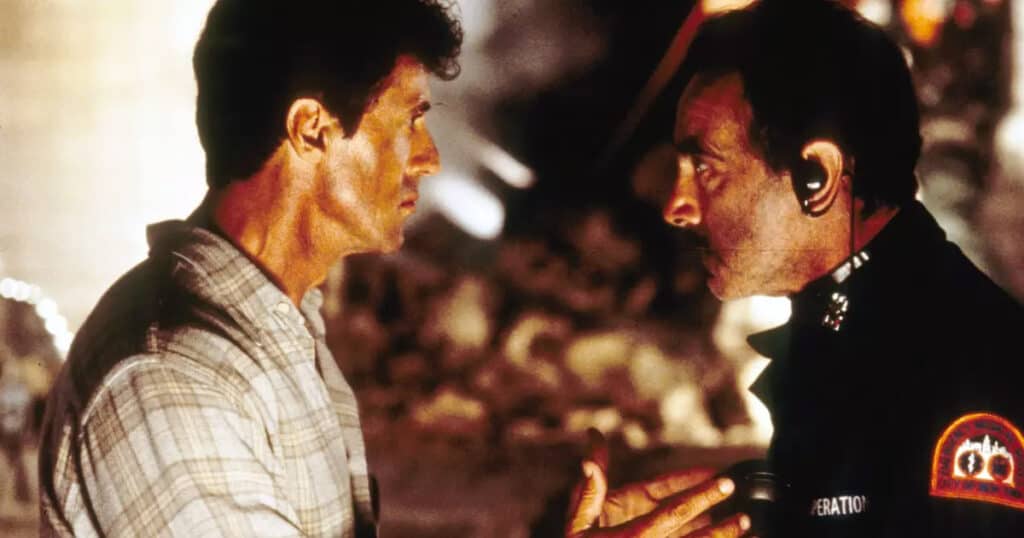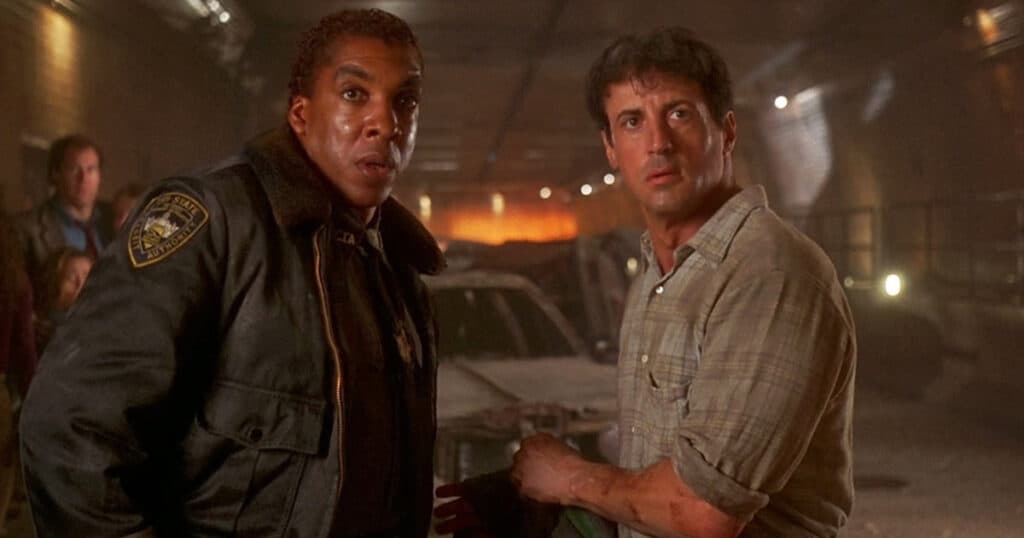We revisit the mostly forgotten 1996 disaster film, Daylight, starring Sylvester Stallone as a man trying to rescue a tunnel full of people.
1995 wasn’t a good year for Sylvester Stallone at the multiplex. His summer tentpole, Judge Dredd, flopped domestically, and it was quickly followed by Richard Donner’s Assassins, which only grossed $30 million at the domestic box office. While Sly’s career had seen a few slumps, his straightforward action movies typically performed, and the failure of those two films put his clout as one of the world’s biggest stars in jeopardy. In this episode of Sylvester Stallone Revisited, we’re going to talk about a movie that was supposed to be a big-budget, commercial change of pace for the actor but wound up being the last would-be blockbuster he’d star in for years. That’s right; we’re going to talk about Rob Cohen’s Daylight.
Flashback to the mid-nineties. Sylvester Stallone had launched a major comeback with Cliffhanger and followed it up with two more global blockbusters, Demolition Man and The Specialist. In 1994, Stallone signed a deal for $20 million to star in a movie for an upstart new studio called Savoy Pictures. The film was never made, but a new benchmark had been set for movie star salaries, with $20 million paydays suddenly the fee all A-listers wanted. Stallone got a rich $17.5 million from Universal to star in Daylight, and before the film went into production, they signed him to a three-movie deal for $60 million, which would mean $20 million a piece. But, the film would underperform drastically, and the three-movie deal would eventually expire, with Stallone only making a horror-thriller for them called D-Tox, aka Eye See You, which would disastrously go direct to video, essentially ending his career as a movie star – for awhile anyway. Like all legends, Sly would make his comeback, but in the late nineties, things were dire.
To this day, Daylight remains an obscure title in Stallone’s library. It was supposed to be a huge film, with Universal spending $80 million to make it. One has to think Stallone’s fans, who were used to him killing bad guys at the point, were disappointed to see him the lead of a movie where the body count happens independently of Stallone’s fists. The movie was part of an interesting mini-trend that occurred in the mid-nineties, where the old disaster film genre was revived.
Before Jaws and Star Wars changed the blockbuster game in the seventies, disaster movies were all the rage. Typically these movies revolved around horrible disasters and featured star-studded casts in melodramatic, soap-opera-worthy roles. There was Airport where travellers dumb enough to go up in an airplane piloted by the always soused-looking Dean Martin had to deal with a mad bomber. There was The Poseidon Adventure, where Gene Hackman, as a turtleneck-wearing man of God, has to guide survivors through the wreckage of an overturned luxury liner. There’s Earthquake, where Charlton Heston and George Kennedy have to deal with an apocalyptic quake in Los Angeles. Best of all, there was The Towering Inferno, where Paul Newman and Steve McQueen, in a star-pairing for the ages, have to save the residents of an out-of-control fire in the world’s tallest skyscraper. The genre petered out when the premises started to get dumber, such as Michael Caine fighting killer bees in The Swarm or Michael Caine, again, returning in Beyond the Poseidon Adventure to recover stolen uranium. By the time an embarrassed Paul Newman had to watch Rocky star Burgess Meredith walk a tightrope across an active volcano in When Time Ran Out while Mr. Miyagi fell to his death, the genre was dead.

But, it came back in 1996 thanks to the year’s two biggest movies – Twister and Independence Day. Only Twister was an actual disaster movie, but ID4 used the star-studded, melodramatic style of those movies, with director Roland Emmerich being the guy still making movies in this genre many years later. Suddenly, studios were green-lighting disaster movies left and right, including not one but two volcano movies, Dante’s Peak and Volcano. The problem? All of these disaster movies flopped, including Sly’s entry, Daylight.
In the movie, Sly plays Kit Latura (what a name!), a former New York City Emergency Medical Services Chief, now working as a Taxi Driver. During his commute, he witnesses a disastrous explosion that traps commuters in an underground tunnel that runs under the Hudson River that’s about to collapse. Sly being Sly, he immediately jumps into action, reclaiming his old job with Emergency Services and undertaking a suicide mission where he enters the tunnel via its ventilation system to rescue the survivors.
Sounds pretty cool, right?
In some ways, yes; in some ways, no. Daylight came out shortly before CGI started to dominate special effects, and some of the practical effects here are incredible. The movie was shot at Cinecitta Studios in Rome, and they were able to flood the sets, set off explosions and do a lot of cool stuff. The explosion sequence that rips apart the tunnel is pretty nifty, as is a nail-biting moment where Kit has to get into the tunnel via a ventilation system where the fans are still moving. Sly’s intensity is perfect, and he relishes playing a more down-to-earth role.
Where the film goes wrong is in all the non-action-related stuff. The director, Rob Cohen, made a few good movies in his time, including Dragon: The Bruce Lee Story and the original The Fast and the Furious. But he’s very melodramatic, and Daylight, which is already going for a soapy vibe, gets pretty cheesy pretty fast. You can tell The Poseidon Adventure was the movie they modelled this on, but the plot lines are embarrassingly dopey. First, the old couple doesn’t want to lose their dog. Don’t worry – the dog doesn’t die, but one of them does. This is viewed as much less tragic. There are the unpredictable juvenile delinquents, one of whom is played by Sly’s late son, Sage, in a decent enough performance (I always liked Sage). Then there’s the estranged husband and wife trying to reconnect while dealing with their rebellious teen daughter, played by future scream queen Danielle Harris. There’s Amy Brenneman as a struggling playwright with a lack of confidence who serves as Sly’s default love interest, with her regular gal role patterned heavily on the similar role Sandra Bullock played in Speed. There’s even a young Viggo Mortensen as a daredevil businessman who tries his rescue but fails miserably, given his billing. None of these plotlines are good, with one exception. Stan Shaw is excellent as the nice-guy transit cop who becomes Kit’s second-in-command and wants to get back to his fiancee, the tunnel operations manager who is watching the tragedy unfold remotely. He brings some depth to his part.

Otherwise, this is pretty cheesy, even if it’s still kind of fun. It’s not particularly well regarded by Stallone fans, and it had the misfortune to come out just as disaster movies were bombing left and right. It grossed an abysmal $33 million domestically, which seriously hurt Sky’s career, even though it did well enough overseas that it likely broke even by the time it hit home video. It was meant to be the beginning of a massive series of blockbusters for Sly, but it would prove to be his last action movie to get a wide release until Get Carter in 2000, and Driven in 2001, both of which would do so badly that Stallone’s career went into deep freeze for half a decade. However, before that, he’d star in perhaps one of his best movies, Copland, where his performance in an atypical part would be so powerful that even his harshest critics fell in line behind him- but that’s a story for another time!
Originally published at https://www.joblo.com/daylight-revisiting-sylvester-stallones-forgotten-disaster-movie/






